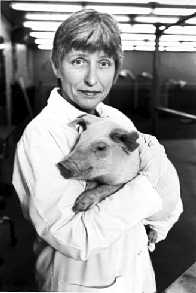- Flu fighters
- You're not the only one bugged by cold and flu bugs.
Researchers have been chasing the elusive viruses for
years. The good news: They're catching up.
It's enough to make you sick. No matter how diligently you guard against them, the seasonal beasts of cold and flu still find a way to knock you flat and leave you sniffling. If it's any consolation, cold and flu viruses - like all of the 2,700 viruses known to science - are elusive creatures to researchers as well. But UW-Madison scientists are making some promising advances in understanding how viruses attack the body, how they spread, and how they change into new forms. "Everybody has the flu - it's part of the disease profile of the world," says Virginia Hinshaw, an influenza researcher and dean of the Graduate School. "But the virus keeps changing all the time. Anticipating those changes is the difficult part." The virus is a genetic quick-change artist because it exists in many different hosts, such as birds, pigs, marine mammals, horses and, of course, people. When two of these viruses infect one host, the viruses "mix" their genes and create new strains. Such mixed viruses are a major threat to humans because they can cause worldwide epidemics. Pigs are a particularly important "mixing vessel" for the flu, Hinshaw says. Pigs have their own viruses, but are readily infected with viruses from people and birds. Human immune systems have no defense against the new strains that arise from that mix. The swine flu epidemic of 1976 had the potential to be severe, but caused less harm than expected, she says. Hinshaw is seeking innovative ways of block-ing those virulent new strains. She is working with a technology called a "gene gun," a pneu-matic device that shoots microscopic gold beads coated with genetic material. Those beads can actually implant a vaccine inside the cell, producing a swift and strong immune response. Hinshaw works with pigs and horses, but clinical trials using the gene gun with humans are under way elsewhere. The DNA-based vaccine could provide an important life-long protection in farm animals, which can die in large numbers from flu epidemics. But by controlling it in animals, Hinshaw says, they are indirectly reducing the threat to people. "If you reduce the flu in pigs, you also reduce the level of genetic mixing that takes place," she says. The flu is a more serious virus than one might imagine. Hinshaw says between 10,000 and 40,000 people in the United States die each year of complications from influenza, and the very young and very old are especially vulnerable. It's also the No. 1 cost to health care and lost productivity through sick days. The challenges other viruses present are formidable. Consider the common cold virus. Biochemist Roland Rueckert says there are more than 100 rhinoviruses that cause the common cold, and those make up only one-third of all
|
 Hinshaw's research is helping to bolster the immune system of pigs, which get sick even more than humans do. "Everybody has the flu - it's part of the disease profile of the world," she says. "But the virus keeps changing all the time. Anticipating those changes is the difficult part."
cold-causing viruses floating around. It's unlikely any one treatment would cover all these different forms, he says. Rueckert describes viruses as machines with many moving parts. Drugs and vaccines are a kind of biological sabotage, jamming a virus' functions the way sand clogs gears in a clock. A long-term virus research project has placed Rueckert's team on the trail of genetic leads. They are growing viruses in tissue cultures to find the proteins these viruses employ to grow and spread. Identifying these pathways of growth is the first step toward designing drugs that can shut down their spread, he says. Rueckert also is studying how viruses such as rhinovirus and polio are able to quickly develop resistance to drugs through genetic mutation. In 1985, Rueckert was part of a team that produced a three-dimensional map of the surface of a common cold virus. The advance enabled researchers to actually see the shapes and surfaces where drugs can bind to the virus - an approach that ignited national interest in the concept of designing vaccines and drugs against other viruses, such as HIV. The good news is that progress is being made: One drug in clinical tests works on 80 percent of all cold-causing rhinoviruses. And a new AIDS drug treatment is showing promise in inhibiting the final stage of the virus's reproduction.
|


